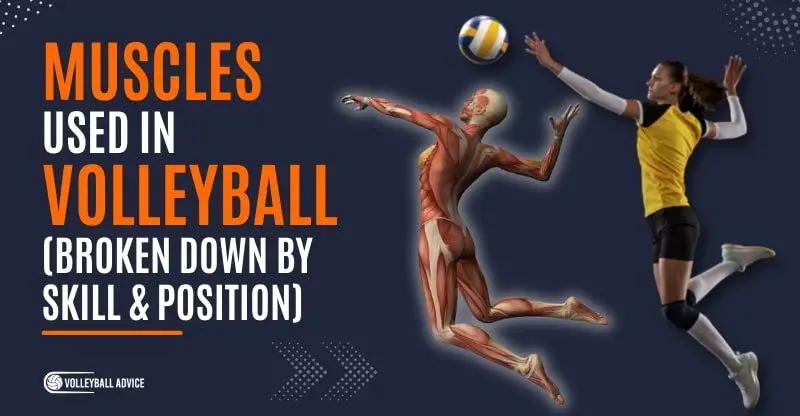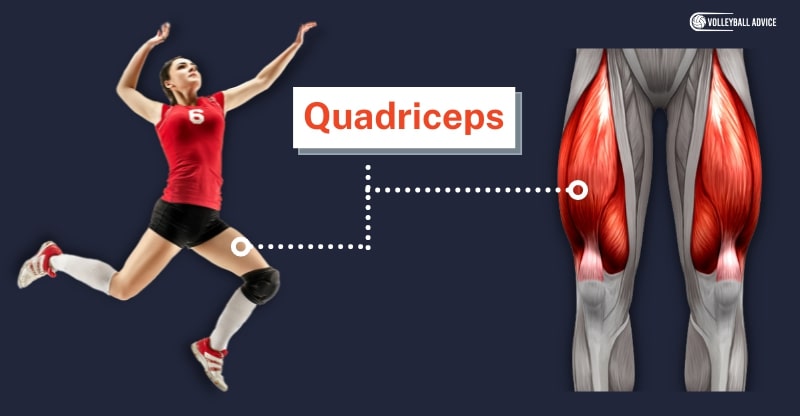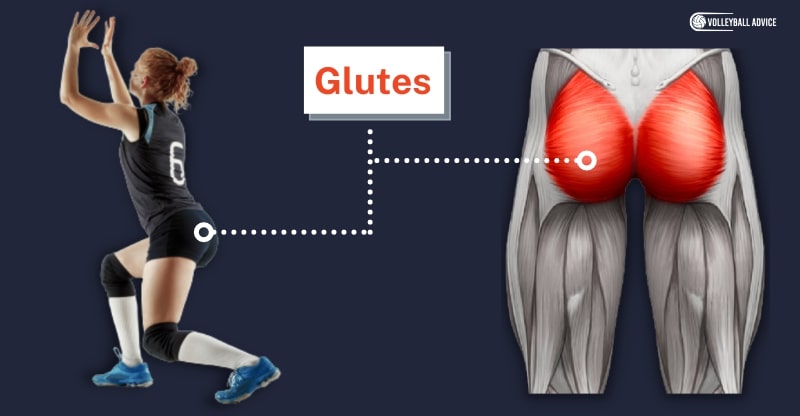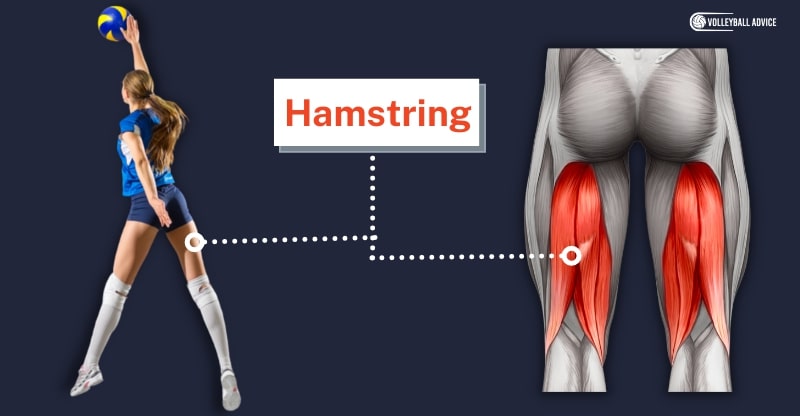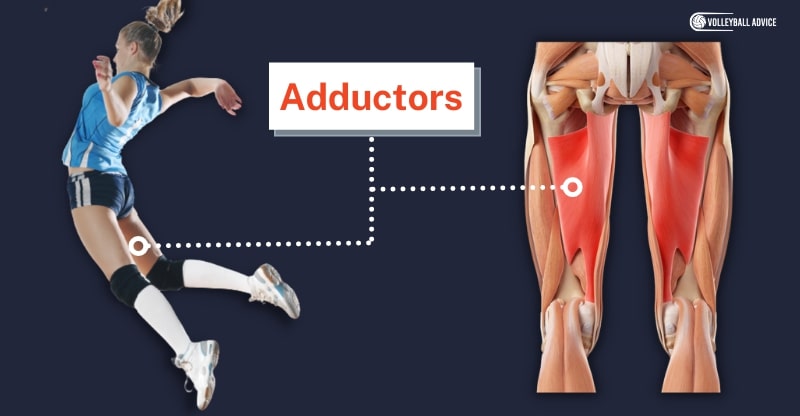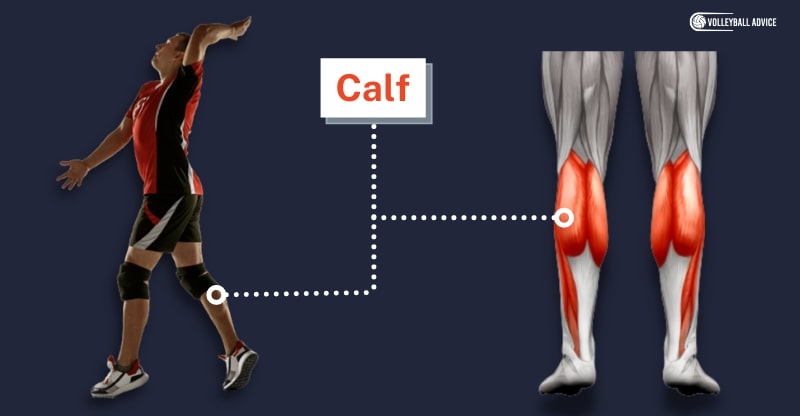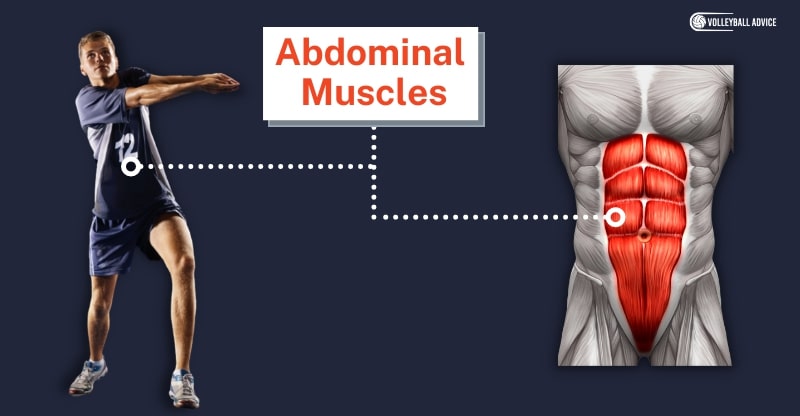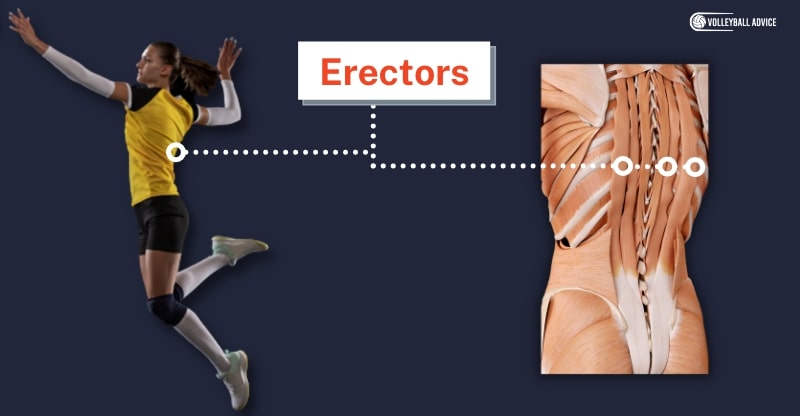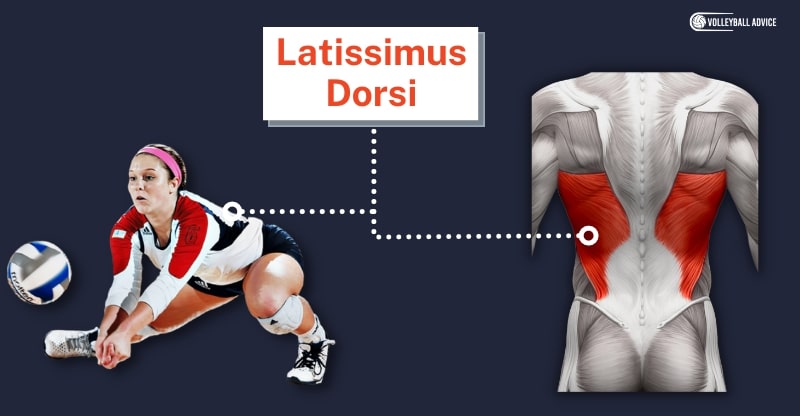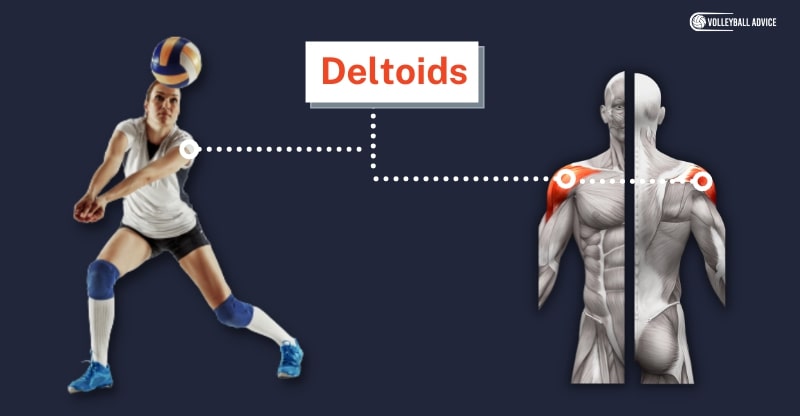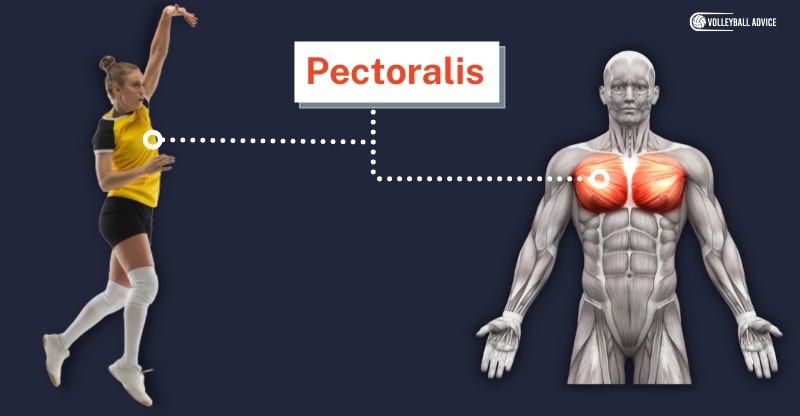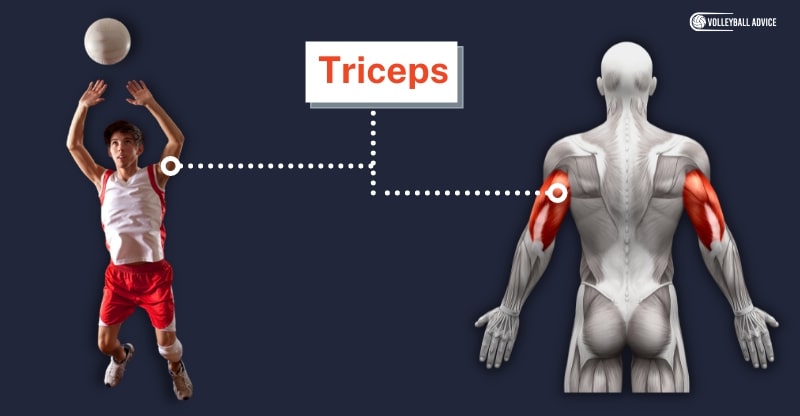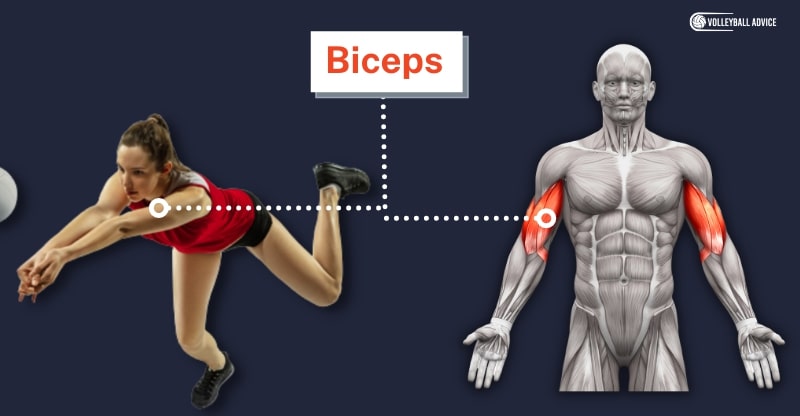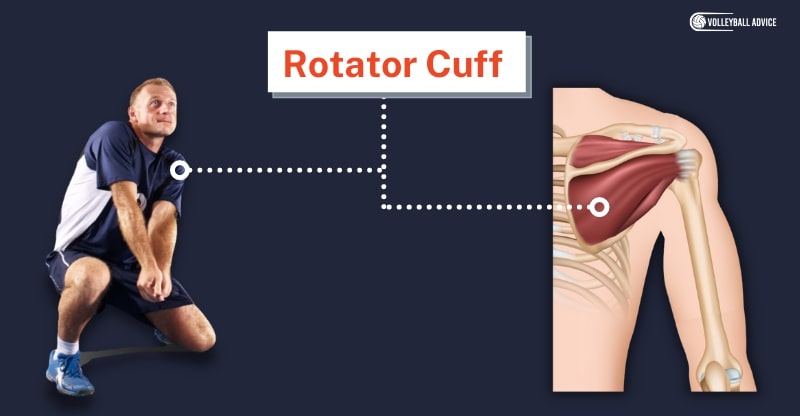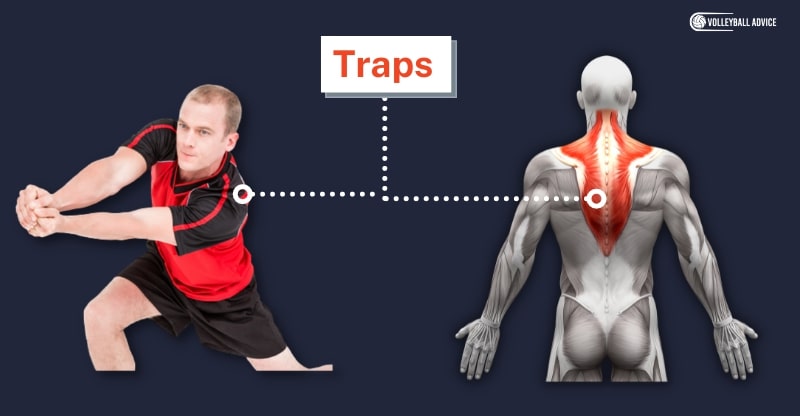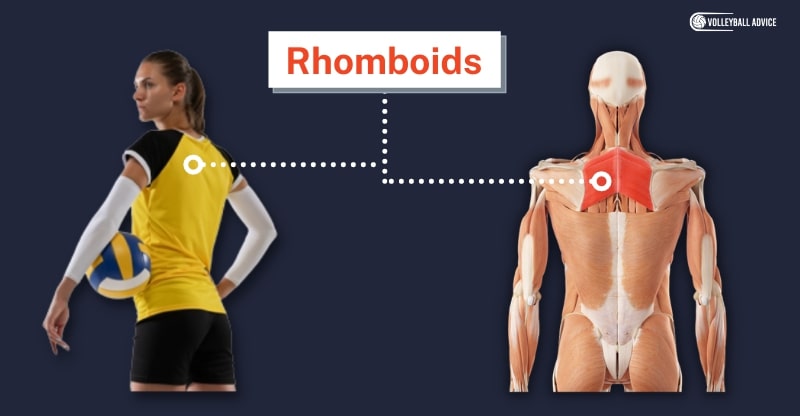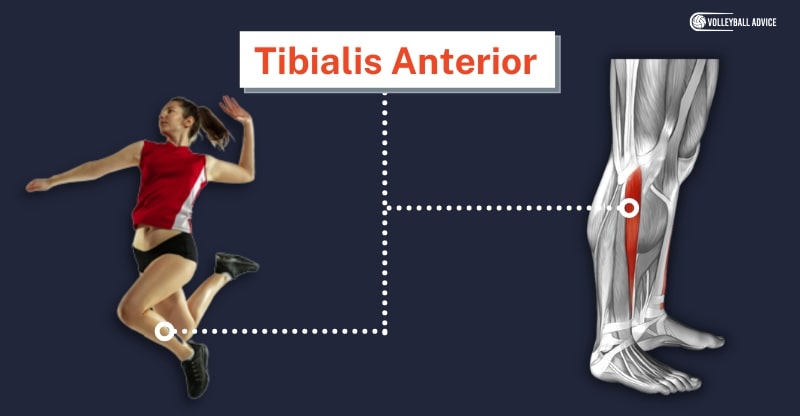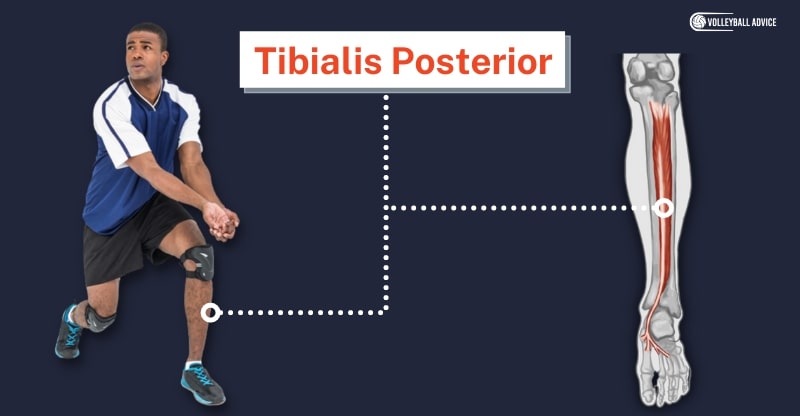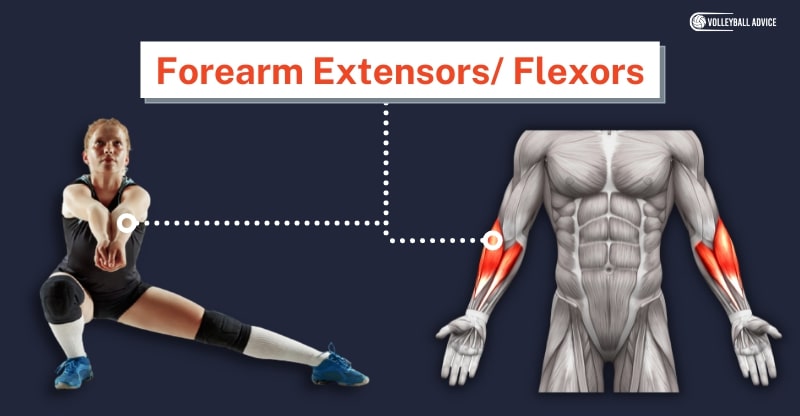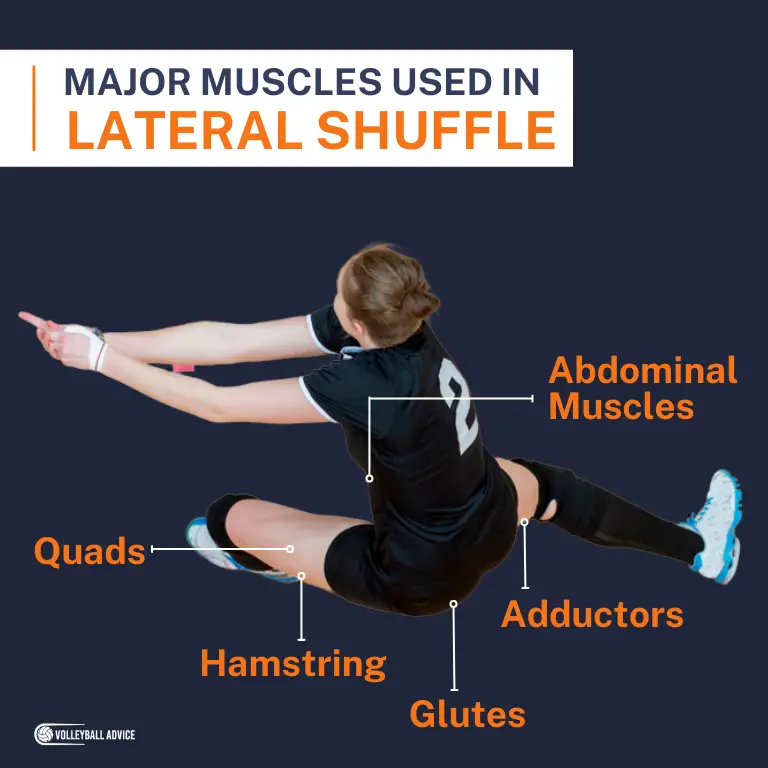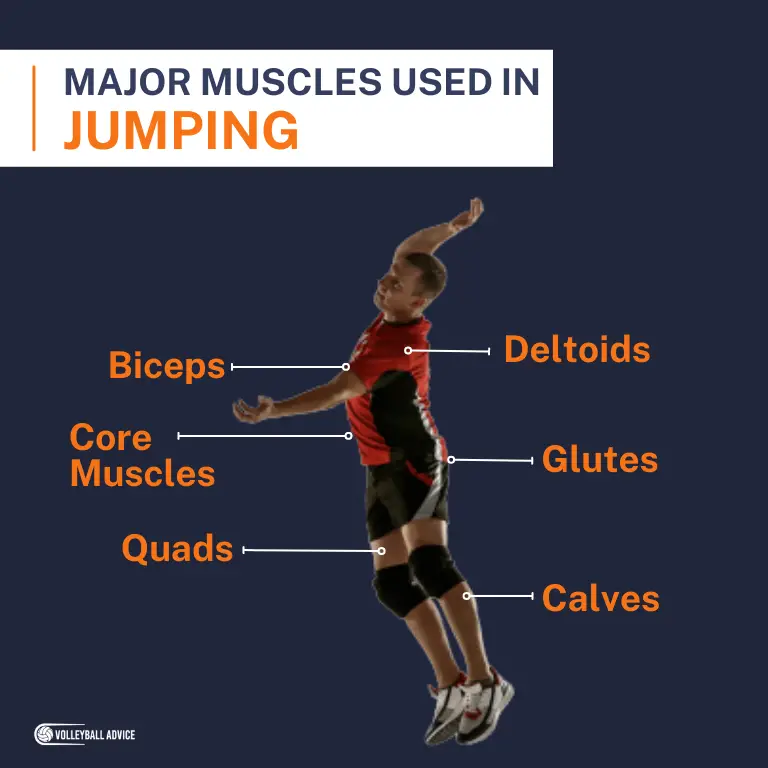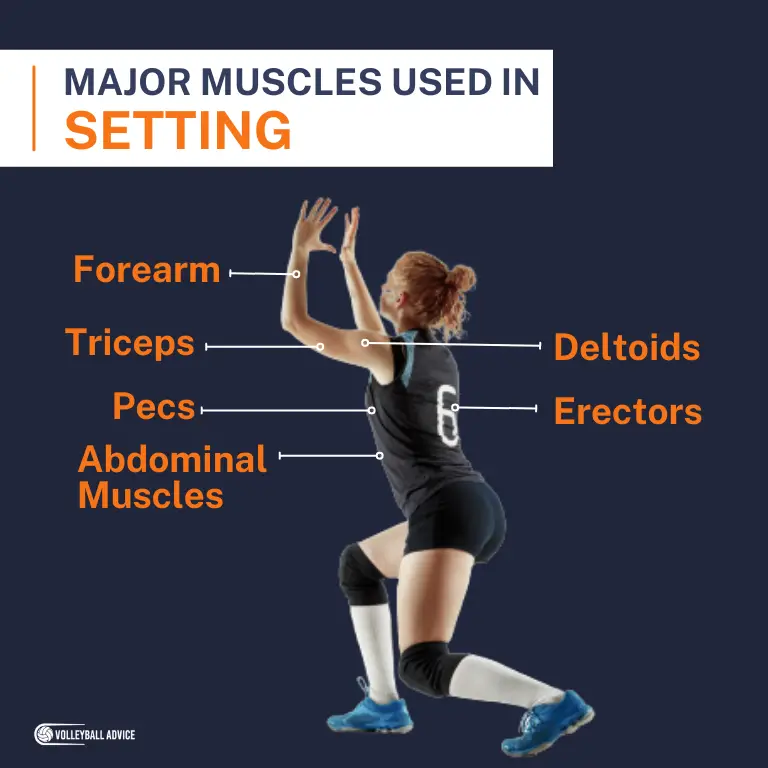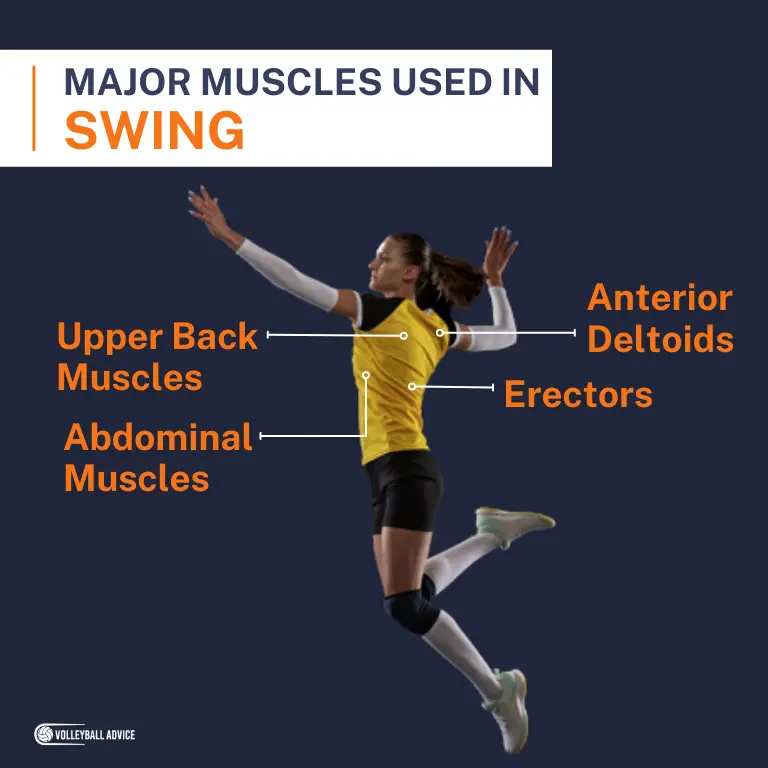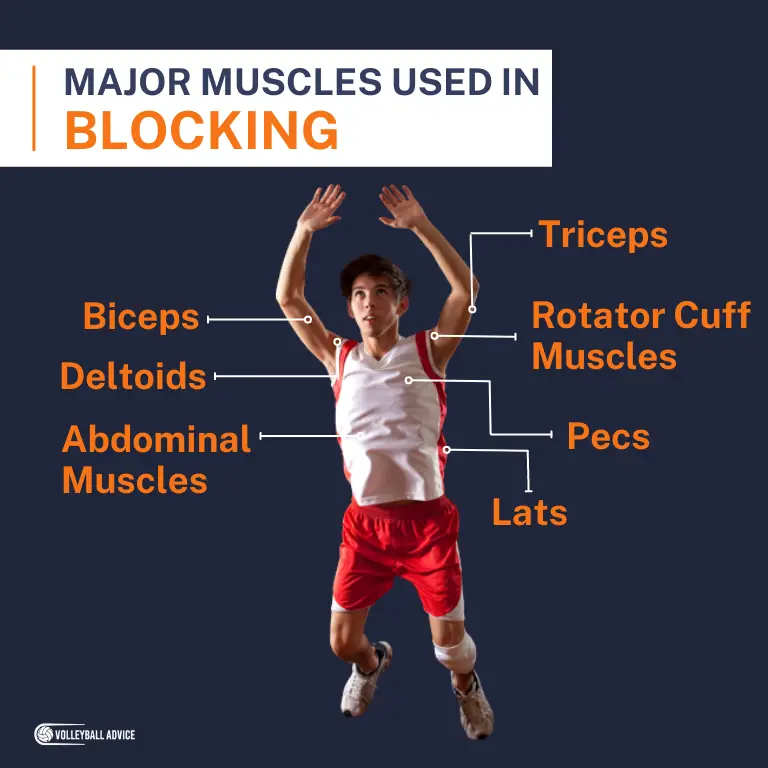Muscles Used In Volleyball (Broken Down By Skill & Position)
Volleyball uses almost every muscle in the body. Yet each skill or position within the sport tends to develop some muscles more than others.
The major muscles used in volleyball are:
- Quadriceps
- Glutes
- Hamstring
- Adductors
- Calf
- Abdominals
- Erectors
- Latissimus dorsi
- Deltoids
- Pectorals
- Triceps
- Biceps
In this article I will discuss more in depth the functions of the muscles listed, common muscles that need to be strengthened to reduce the chance of injury, and which muscles will help you improve different aspects of your game.
What Muscles Are Used In Volleyball?
Primary Muscles
Primary muscles or prime movers are muscles that produce most of the force for motion.
The primary muscles for volleyball are:
Quadriceps
The quad muscles extend the knee, straightening the leg. They will be used for accelerating you in stepping forward or backward, and jumping. They will slow you down when landing, or changing direction on the floor.
Glutes
The glutes are 3 different muscles. The gluteus maximus, medius, and minimus.
The maximus, helps extend the hip moving you forward to lunge or up to jump. It is one of the main muscles for creating jump height.
The medius does play a significant role in lateral movement. However it and the minimus are more for stabilization of the hip and knee. This makes them primary and secondary muscles in volleyball.
Hamstring
The hamstring muscles extend the hip and flex the knee. Extending the hip is a crucial part of how you jump high. Although the glutes will have more impact on your hip extension than your hamstring.
The knee flexion caused by the hamstring will help you bend your legs before jumping as well as to get low for a dig.
Adductors
The adductors (inner thigh) help pull your legs together and create some hip extension. This means they will play a small role in jumping, but mostly be used for stability, and lateral movement.
Calf
The calf muscle is split into two: gastrocnemius and soleus.
Gastrocnemius when contracted helps extend your ankle and has a roll in flexing the knee. It’s composition is of more explosive muscle fiber types(Type II) than the other muscles that do the same action in your lower leg. This makes it an important muscle for jumping.
Soleus muscle sits underneath the gastroc and extends your ankle as well. It is made up of fibers that are meant for endurance (Type I). It will help you move around the court for the entirety of the game.
Abdominal Muscles
Your abdominals help resist extension for blocking, flex and rotate your core for serving and hitting, and stabilize your spine as you move around the cort and jump.
The abdominals used for general stability would be the transverse abdominis, pelvic floor, multifidus, psoas and diaphragm.The abdominals used in blocking and hitting would be rectus abdominis and obliques
Erectors
Spinal erectors extend your back helping you lean or arc backwards. This is beneficial for hitting and setting.
Lats
The lat muscle will assist in some stabilizing and creating rotational power in your trunk. Depending on your position it will probably be most used for shoulder extension and adduction, bringing your arm towards your body and down as you hit.
Deltoids
The deltoids help with shoulder abduction, flexion and extension. This means they will be involved anytime your arm is overhead in setting and swinging as well as when you dig.
Pecs
The pectoralis major adducts, bringing the arm towards the body and internally rotates the arm. This will help you bring your arms together to dig or set the ball as well as down to hit.
Triceps
The triceps extend the elbow, straightening the arm. This may happen at a moderate pace for a dig, or explosively for hitting and setting.
Biceps
The biceps flex the elbow and shoulder, bringing your hand towards your shoulder and your elbow above your shoulder. It will play a role in shoulder stability when you dig. You will also use your bicep anytime you raise your arm to dig or set.
Secondary Muscles
Secondary muscles or stabilizer muscles are ones that create joint stability in movement. Almost every muscle in the body will play a role in stabilization in such a dynamic sport.
Some of the most used secondary muscles for volleyball are:
Rotator Cuff
Rotator cuff is a name for 4 muscles: supraspinatus, infraspinatus, teres minor and subscapularis.
These muscle are key for the shoulder stability needed for digging, setting and hitting.
Traps
The traps play an important role in shoulder function and stability. This is crucial in a sport that requires bringing your arms in front of you or overhead in a variety of positions.
Rhomboids
The rhomboids help retract the shoulder blade. This means bringing it towards the spine. This is an important part of slowing down your arm after a swing.
Tibialis Anterior
The tibialis anterior is a lower leg muscle that runs along the front of your shin and into the foot. It plays a vital roll in stability on one leg. It creates bending in the ankle and stabilizes side to side rolling of the ankle as you take off and land from step or jump.
Tibialis Posterior
Tibialis posterior, runs down the back of your tibia bone to the big toe. It is part of what is called your deep calf compartment. This muscle is important in volleyball as it drives the big toe into the ground as your last point of contact for takeoff in a jump.
Like the like tibialis anterior it helps stabilize rolling in the ankle
Forearm extensors/ flexors
The muscles of the lower arm have a few important functions in volleyball. They will control your fingers for setting and also have to have the mobility to draw the fingers towards your wrist and then whip the hand as you hit.
Common Weak Muscles for Volleyball
Technique has a huge role in injury and performance in sports. However, even if you know proper technique, if a muscle is weak, it may not allow you to move the way you want to.
Below I will cover a few common injuries and movements and the muscles that could be strengthened to reduce your chance of injury or improve your game.
As volleyball is a multi directional explosive sport this is not a complete list of training needs and possible injuries. Listed are some common areas for improvement I have noticed in working with volleyball players.
Note: If you are experiencing pain from playing, it is recommended you visit a health care practitioner to assess and create a specific treatment plan for your injury.
Ankle Mobility
Limited ankle mobility is associated with ankle sprains and many other lower body injuries. A common way to test for mobility is an ankle dorsiflexion test.
Some minimums you will want to be able to achieve are to have your toes 10cm away from the wall in a kneeling dorsiflexion test.
If you are unable to touch the wall with your knee tracking over your mid foot at 10cm, you may want to consider strengthening your tibialis anterior, posterior and other foot muscles.
Shin Splints
Shin splints are another injury that can develop from lots of jumping. The injury can occur when there is significant increase in intensity of training, for example the start of the season.
Strengthening your tibialis anterior and posterior can help minimize your chances of developing shin splints.
As shin splints are an overuse injury, another strategy is to manage your jumping loads or contacts.
This means make sure you are doing some jump training in the off season to maintain strength.
In season, you will manage your contacts by doing less jumping in your strength training especially around practices that have a lot of jumping, or tournaments.
Patellar Tendonitis
Patellar tendonitis or jumper’s knee is another common problem for athletes that jump a lot.
Stretching the quads and keeping proper ankle, and hip mobility are important parts of reducing your chances of developing this.
Eccentric training of the quads can also help. This means being slow and controlled when lowering into a squat or lunge.
Knee Valgus
Knee Valgus is a term for the knees collapsing towards each other when squatting.
Knee valgus has two implications when jumping:
- First, your jump technique will be worse, meaning you will produce less power and not jump as high.
- Second, you increase your chances of injury when landing from your jump.
Common reasons for knee valgus are weak foot muscles, lack of ankle mobility and weak hip external rotators.
Strengthening the gluteus medius and activating it as part of a warm up routine are a great way to make sure your hips are strong and working properly.
Learn more in my article: 13 Best Leg Exercises For Volleyball Players
Low Back
Low back discomfort is another possible complaint of volleyball players. If you experience this please have it assessed from a health care practitioner as there are many possible causes and is not necessarily from playing alone.
However people can experience low back soreness from play as the serve receive position, digging, setting, and hitting, all require much more of your back than most peoples every day use.
Strengthening the back extensors and core muscles through posture exercises and back extensions may help.
It is also critical to maintain good mobility through the thoracic or upper back. If this is not maintained, the low back can start to compensate for the extension and rotation needed in the upper back for setting and hitting.
Upper back mobility is maintained through thoracic mobility exercises as well as shoulder stability exercises. If the shoulder is not stable, repeated hitting causes it to tighten, having a ripple effect into the upper and lower back.
Shoulder
With the shoulders it is important to develop strong reflexive stability through your rotator cuff muscles and upper back muscles. These are the muscles that slow the arm down when hitting.
Another way to think of the rotator cuff is the breaks for your arm when you swing. These muscles are quite small in comparison to the lats and pectorals which accelerate the arm.
If you are doing volleyball specific weight training a general guideline would be to do pulling exercises, ones that work your lower and mid traps, rhomboids and rotator cuff, 2-3 times as much as you do pressing exercises, ones for the chest and triceps.
Related Article: Reaction Time in Volleyball: 4 Specific Drills To Master
Muscles Used In Volleyball By Skill
Most movements in volleyball use a significant number of the muscles in the body. Below I will cover some of the prime movers that by training and strengthening will help you be better at these skills.
Lateral Shuffle
Moving from side to side happens by extending the back or driving leg knee and hip and being able to land with stability on the leading leg.
Strengthening your quads will improve your ability to extend the knee quickly and propel yourself sideways.
The glutes also will play a significant role in driving the hips sideways on the back leg and stability on the leading leg you are landing on.
Having strong adductors and hamstrings will help with bringing the legs back together so you can shuffle again, or have your legs in position to jump.
In order to stay in control when changing direction from side to side or sideways to jumping, you will want strong abdominal muscles that hold your posture.
Jumping
Hip extension is where the majority of your power comes from in jumping. For this reason if you want to jump high, strong glutes are a must. can i buy ambien in canada https://www.livermedic.com/
The next most important muscle to strengthen is your quads as they will take your knees from bent to straight.
Your calves and core also play a role in improving your jump. The calves will extend the ankle and the core transfers the power from your legs through your torso, keeping you upright and balanced.
Your deltoids and biceps can be used to help create upward momentum with your arms in a jump. Exactly how you use your arms, and core muscles will depend on if you are combining it with setting, swinging or blocking. Because of this, most of the time the arm muscles will have little impact on your overall jump height.
Setting
The triceps, pecs, and deltoids play the biggest role of major muscles in setting.
The triceps need to be able to quickly straighten the elbow to launch the ball.
Having strong and well trained deltoids will help you repeatedly bring your arms overhead and control where your hands are.
It will also be important to have endurance built in the deltoids and triceps. As they fatigue it will get harder to control the muscles making setting less accurate.
The pecs will also create a little power for your set as you push or press the ball away.
The forearm flexors and extensors will control the wrist actions of the setting. This means they need to have the strength to control the hands and fingers and the mobility to catch and redirect the ball in the direction you want it to go.
The abdominal muscles, and erectors will also be used to position the torso for the set as well as create or transfer leg power into the set when needed.
Swing
Swinging for hitting or serves have 4 major muscles producing arms speed in the shoulder and elbow.
The anterior deltoids or front of the shoulder in combination with the pecs will start to pull the shoulder forward. As you move into the later phases of the swing, the triceps will straighten the elbow and and the lats will whip your arm by your side.
Being able to quickly contract those muscles through the range of motion of a swing is what will produce arm speed.
Abdominal muscles and erectors will help rotate and extend your torso to prepare you for the swing. After which the abdominal muscles, obliques and rectus abdominis will rotate and flex your torso to produce a significant amount of your power.
Hitting puts significant stress on your upper back muscles as they are responsible for stabilizing the shoulder and slowing down the arm in this explosive movement. Strong and well functioning lower and mid traps, rhomboids and rotator cuff muscles will not make you hit with more power, but it will keep you hitting injury free.
Blocking
Having a strong block has a lot to do with your abdominal muscles. The rectus abdominis helps resist extension. This means when the ball hits you, it will help keep you from being pushed backwards.
The rotator cuff muscles will aid with some initial stability, but if you are successful in your block, you will be resisting significant force. Your body will respond by producing force in the opposite direction to how you are impacted.
Depending on your arm position, and where the ball contacts you, you will use your muscles slightly differently. But, likely you may use your deltoids, pecs and lats to keep your arms and place and redirect the ball.
The delts will initially be used to hold the arms overhead. If there is impact with the ball they may also push back on the ball by bringing your shoulder forward.
The pecs will also bring your shoulders forward if the ball hits your arms or hands.
The lats will pull your arms down, like in a swing, bracing you. This stops your arms from just being pushed backwards, making your block ineffective.
The biceps and triceps will aid in stabilizing the shoulder and elbow. Keeping the arms straight.
Related Article:
- Best Exercises For Volleyball + Workout Routine
- How To Improve Coordination & Balance In Volleyball
- 12 Best Volleyball Upper Body Exercises & Workouts
- 11 Exercises To Improve Your Volleyball Spike
- 9 Power Exercises For Volleyball Players (Sample Program)
- 7 Best Arm Workouts For Volleyball Players
- Sprint Workouts For Volleyball (6 Examples)
- How To Jump Higher in Volleyball (Science-Backed)
Final Thoughts
There are two ways muscles will be used in volleyball prime movers and secondary stabilizer muscles.
The prime movers are quadriceps, glutes, hamstring, adductors, calf, abdominals, erectors, latissimus dorsi, deltoids, pectorals, biceps and triceps.
Most of the rest of your muscles in your body play a role in stability at some point but some main secondary stabilizers are the rotator cuff muscles, gluteus medius, and tibialis anterior and posterior.
For exercises to improve your game or reduce your chances of injury, read my other articles that give more in depth training recommendations and sample programs.
About The Author
Ian started his strength and conditioning career working with elite youth volleyball athletes. Before coaching, he completed a BSc in Biomechanics at the University of Calgary. He has over a decade of experience working as a kinesiologist and strength and conditioning coach, with teens to octogenarians in positions with community gyms to elite sport. Outside of coaching, you can find Ian learning new sports, skiing, river surfing, hiking, and traveling. If you have questions or are interested in opportunities to work with Ian, connect with him via Instagram, Linkedin, or Website.

